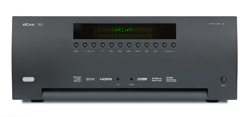
Introduction to the Arcam AVR750 Receiver
Receivers are hard to review. It’s almost impossible to directly compare them to another model as there is so much wiring involved. Attempting to rely on memory has its own challenges, as it can be unreliable when it comes to audio. With all the difference sections of a receiver, from audio and video handling, to room correction and amplifiers, it is difficult to determine what is performing right and what is wrong. Two recent changes have made me enthusiastic about evaluating receivers again despite the inherent challenges.
ARCAM AVR750 RECEIVER SPECIFICATIONS
- Design: 7.1 A/V Receiver
- Power Output: 100 WPC x 7, 1 kHz, THD 0.2% @ 8 ohms
- Video Connections: HDMI 1.4a (7 rear in, 2 out), Component (3 in), Composite (4 in, 1 out)
- Audio Connections: USB 2.0, RCA Stereo (6 in, 1 out), Optical (2 in), Coaxial Digital (4 in,), Multichannel (7.1 output)
- Other Connections: Ethernet (Internet Radio, Networked Audio, Firmware), 12V triggers (4), RS-232, Headphone Jack (3.5mm)
- Dimensions: 16.73″ H x 17.04″ W x 6.73″ D
- Weight: 36.8 Pounds
- MSRP: $6,000 USD
- Arcam
- SECRETS Tags: Arcam, Receivers, Audio, 7.1
The first is the excellent series of articles from Dr. David Rich about the system design of AVRs and processors. Learning about all the design choices, from the volume control chip to XLR connections versus RCA connections has been enlightening. It has also helped to shine a light on why one receiver might cost 2-3x as much as another receiver, even when the specs most people read look to be identical.
The second is the ability to test equipment to the limits with help from Audio Precision. Having access to their APx series of analyzers has enabled me to test functions that are rarely seen in A/V reviews, and try to isolate what components are designed well and what flaws there might be. With these two items in mind it was with great anticipation I delved into the Arcam AVR750 receiver, the flagship model from the well-regarded UK company.
Design and Setup of the Arcam AVR750 Receiver
The Arcam AVR750 is a beast when you lift it. Though it only comes in at 37 lbs. it is a dense component that feels much heavier. The design is the same look that Arcam has been using with their components for years. The front is a dark matte gray and a slight curve to it with some buttons and a total absence of knobs. Much more interesting is the rear with its selection of inputs and outputs. A surprising omission is a multichannel input as some people still prefer multi-channel audio over analog from components like the Oppo BDP-105.
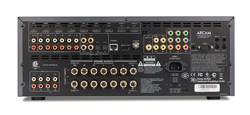
There is a selection of 7 HDMI inputs along with 3 component video and 4 composite video inputs. S-Video inputs have now vanished for everyone it seems. There are 6 stereo RCA inputs along with 4 Coaxial and 2 Optical inputs for audio but no phono stage. Streaming audio is available with the Ethernet input and there is also a USB input for music. There is a front 3.5mm input (analog and optical) for your portable media devices as well.
There is also no Bluetooth or Airplay included with the Arcam. You will need to add on a streaming device, like an Apple TV or Arcam’s own streaming boxes, if you want to get music from your phone or computer to the Arcam to listen to. This isn’t expensive to do, but as more and more people stream content the lack of any support for that is a bit odd.
The AVR750 does not use the AVR LSI chip that degrades the performance of most AVRs but instead uses many individual ICs optimized to yield better performance.
The performance enhancement will be seen in the measurement section. The volume control chip is the Cirrus CS3318. The current full line of Arcam AVRs uses this chip.
The amplifier section of the Arcam AVR750 is a Class G device. This allows the first 50 watts of the Arcam AVR750 operate as a standard class AB amplifier with a DC power supply voltage rail (30V) that will allow the amp to produce 50 Watts average power into 8 ohms When more power is needed it can switch the DC power supply rails (60V) to produce up to 210 Watts in stereo and 100 Watts per channel with all channels driven. . The Class G amp is more efficient than a Class AB since power dissipated by the output transistors is the same as a small 50 Watt amplifier except when the instantaneous program amplitude requires more than 50 watts to be dissipated to the speaker. For this small period of time the amplifier dissipates heat of the power of a 200-watt amplifier.
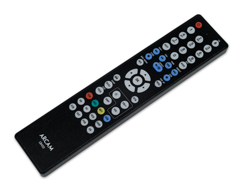
The disadvantage of Class G is the switching action of the supply rail can introduce a distortion term. This will be seen in the measurement section.
The lower priced Arcam AVRs in the current lineup use class AB amplifiers.
The Arcam AVR750 includes its own room correction system that is proprietary to their hardware. With the included microphone it manages to place my speakers the correct distance away, down to half an inch, and has accurate crossover points for them. The process completes in less than 10 minutes and with accurate results, I would recommend using it. By default the Arcam does not enable any room correction.
The included remote is a small backlit number that is functional but nothing distinctive. It works well enough but when you are spending this much for a receiver I would like a model that uses RF instead of IR, and that provides a screen with feedback. Most people likely will use the Arcam with another control system so I imagine this remote will not matter to most.
I tested the Arcam AVR750 in two different systems: One consisting of five Paradigm Millennia One speakers and an SVS PB-1000 subwoofer and one utilizing Definitive Technology Mythos STS speakers, a Mythos 9 center and Gem surrounds with the same PB-1000 subwoofer. Arcam provided their BDP300 Blu-ray player with it as well, which I utilized along with my usual Oppo BDP-105 and BDP-103D for sources.
The Arcam AVR750 Receiver In Use
I’ve been wary of Class G amplifiers as every design has an inherent weakness but I do not find that with the Arcam AVR750. From the opening chords of Dave Matthews and Tim Reynolds: Live at Radio City to the finale, it just sounds musical. There is nothing overly sharp in the treble or loose in the bass and midrange. The AVR750 maintains complete control over the soundstage at all times. The guitars sounds like guitars and that is a tone many components get wrong but not the Arcam. The sound and ambience of the hall is clear and reproduced well. Using the room correction brings the bass under better control while not causing the performance to slip out of focus.
With the high-energy Monsters University the Arcam does a fantastic job with the surround sound mix. From the sound of Dean Hardscrabble flying around the classroom to Mike and Sully chasing a pig you are immersed inside of the animated world. All the tiny sound effects are audible in the mix while voices are crystal clear.
The soundtrack for Rush is even more impressive. From the opening scene you are right inside of a race car, hurtling around the track at speeds well past 100 MPH. The sound mix is aggressive with a thunderous low end and surrounds that are always in use. With the Arcam AVR750 you never lost cohesion between speakers or wonder where a specific sound is coming from. From raindrops during a race to a terrifying car crash, every detail is there.
The SACD of Wish You Were Here over HDMI provides a similar experience. Through the Arcam AVR750 the subtle sounds of breathing are there as the guitars ring out. The detail fall short of the Yamaha CX-A5000 and Halo A31 combination I last reviewed, but that setup costs more than the Arcam does. It also moves you from the simplicity and ease of a receiver to the more complicated world of separates.
High Resolution downloads can take full advantage of the DACs inside the AVR750. You can stream files to it using the Ethernet jack and an iOS app from Arcam. In use I found the iOS app to be functional but not as easy to use as some controllers. It does get the job done and let me listen to my favorite tracks without needing the normal remote at all.
The Arcam AVR750 sounds fantastic with everything I listen to. From acoustic rock to the loudest action movie, it comes up strong in all situations.
The Arcam AVR750 Receiver On The Bench
The Arcam AVR750 testing uses an Audio Precision APx585 analyzer. For all tests except for the power amplifier section we use the multichannel RCA pre-outs. This allows us to test the preamp section of the AVR750 and then test the power amp section separately. Dr. David Rich has contributed most of the analysis here since he knows this far better than I do.
One interesting thing that we found is that the maximum output levels at preamp out must be set below unity gain. Using the analog input with a 2VRMS signal the maximum output level the AVR750 can drive without going into protection is 900 mVRMS. Two issues with the power amp prevent use with an external amplifier
- The gain of the power amp is higher than normal. It thus clips sooner then a standard power amp. The typical amp gain is 20. This Arcam amp has a gain of 38. With the higher gain 900mV RMS drives the Arcam to full power (150Watts average). For an amp with a gain of 20 the clipping level would be 1.7VRMS. The gain on the Arcam matches the gain on their external amplifiers.
- Some AVRs can operate when the amplifier is clipping. The Class G amplifier of the Arcam is more sensitive to be driven into sustained clipping since clipping forces the amplifier to stay on its high voltage rails for a much longer percentage of time than a sine wave or music below clipping.
With a digital signal at full scale (0dBFS) another issue is noted. With the level control adjusted to unity gain the signal is at 1.6VRMS. This is too large and the volume control must be reduced to bring the output back to the 900mVRMS maximum level before clipping. Why would Arcam design a product that would clip the amplifier at digital full scale? The answer is they assume that some attenuation will occur in the process of normalizing all the speaker in the room to the same SPL. They assume the floor standing front channels will require more attenuation then the rears owing to the likelihood the front channels are closer to the chair and probably more efficient. If the attenuation needed is -5dB the maximum output is restored to 900mV with the volume control at unity gain, which optimizes the SNR. For our tests the attenuation of all channels was 0 dB.
Digital Measurements
THD+N with a 1 kHz sine wave at 1.6VRMS measures in at 0.004%. The same value was found for THD alone. The amplifier did not shut down with levels greater than 0.9VRMS because the AP distortion test is performed quickly and the level above power amp clipping for a short period of time.
The filtered (20 Hz – 20 kHz) signal-to-noise ratio checks in at 103dB relative to 0dBFS at 1.6VRMS. SNR is lower here since the DAC contributes noise as well as the analog electronics. How this SNR would change if the volume was reduced so 0dBFS at the preamp was set to the clipping value of power amp (900mV) is unclear. It is dependent which of the two noise sources (DAC or volume control) dominates.
Noise from the power supply comes in at -120 dB or lower. With respect to the tones around 1kHz Nick Clarke, Engineering Director of ARCAM writes:
“These low level idle tones are a function of the jitter reduction. They are close in and at a very low level so much more acceptable than the standard jitter spectrum of HDMI”.
The jitter reduction system used by Arcam is proprietary.
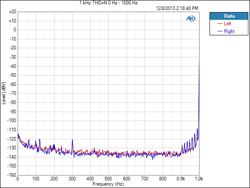
The frequency response is down 0.5dB down at 30kHz with the digital sampling rate at 192K samples per second. This rolloff occurs earlier than other products we have tested.
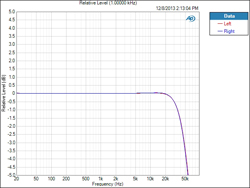
The THD+N Ratio vs Frequency chart shows a surprising rise at 2 kHz. Talking to Arcam this is due to the substitution of an inferior capacitor in this signal path by the Far East subcontractor. This is said to be corrected in current production units.

THD+N vs. Level shows distortion and noise dropping until 900mV at which point it starts to rise. The signal level starts at 5 uV, which is dominated by noise and would not be heard.
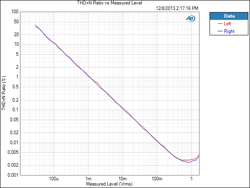
The DAC linearity chart shows that from -95 dBFS to 0 dBFS is flat but then the error starts to come into the graph and is -105dBFS is 3dB.

Using a -60dBFS signal at 1 kHz, we see a noise floor that is flat out to 24 kHz and then starts to rise. This is indicative of a Delta Sigma DAC, much like the noise produced by DSD.
The start of the rise is dependent on the DAC design. With some DACs the rise starts at a higher frequency and sometimes cannot be seen in this plot as shown in previous reviews.

Time domain plots at -60dB and -90dB are not shown. The AP did not produce the plots as it was unable to trigger on the waveforms for reasons that are not clear. We have not seen this problem with other products tested.
Analog Measurements
Looking at analog measurements now, the THD+N is 0.0013% at 900mV and the SNR is 110.8 dB. The SNR value is lower than some other products tested since we are limited to referencing it to 900mV RMS power amp clipping point. The SNR would be 117.7dB if referenced to 2VRMS as we do for other products. The Arcam preamp can source 2VRMS and would achieve this SNR were it not for the power amp shutdown
The 117.7dB value is 6dB better than the analog stages we have tested with an LSI AVR chips. This is discussed in detail at the link below:
Frequency response is flat from 20Hz to 30kHz and down 0.4dB at 80kHz.
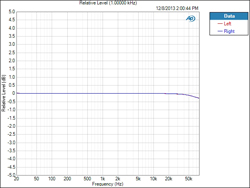
Power supply noise is below -135dB except for a 60Hz spur at -125 dB.
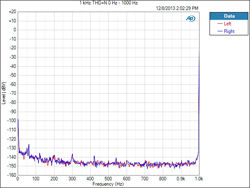
Crosstalk is -90dB from 20Hz to 2kHz. It then moves from -90dB at 2kHz to -65dB at 50kHz at 20dB per decade. The flat floor below 2 kHz indicates coupling between the channels is no longer dominated by capacitive coupling.
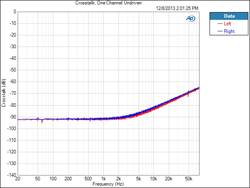
The figure below is THD + N vs. level (VRMS) at 1kHz. Note this graph the signal starts at 1mV and the graph for the THD + N vs. level in the digital section above starts at starts at 5 uV. The digital graph is this expanded making it look different than the graph below.

The figure below is THD + N vs. level (VRMS) at 10kHz.
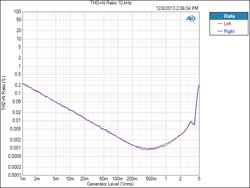
The THD + N vs. frequency at 900mV is shown below.
Note: The Arcam limits us to 900mV RMS full scale to prevent power amp clipping so you cannot compare the results to products for which we use a 2VRMS level. At 900mV the distortion will be lower.
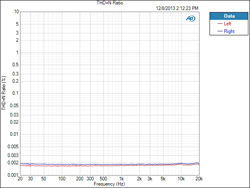
The spectral of a 1kHz signal at 900mV is shown below. Note the 2nd harmonic is below -100dB (0.001%) and the 3rd harmonic is below -110dB with all higher order harmonics below -120dB (0.0001%). This spectra looks much better as a result of the use of the Cirrus volume control but again direct comparison is not possible since the other products were tested at 2VRMS.
The noise floor level of the graph, related to but not the SNR value from 20Hz – 20kHz, is lower than what is seen in reviews we have done with the AVR LSI.
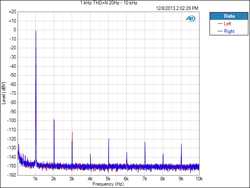
The spectral of a 1kHz 19kHz – 20kHz IM is shown below. Each input is at 450mVRMS so the peak to peak amplitude of the composite waveform does not clip the amp. All in-band spectra are below -120db and the out of band 2nd harmonics are below -110dB. Again this spectra looks much better than most other AVRs tested as a result of the use of the Cirrus volume control but one most note that direct comparison is not possible since the other products were tested at 1VRMS for each input level.
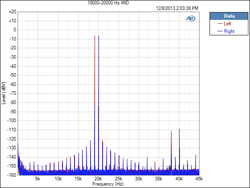
Running two channels into 8 ohms the AVR750 manages 139 watts at 0.1% THD+N and 146 watts at 1.0% THD+N at 1kHz. At 4 ohms we see 207 watts and 221 watts. Both are better than the specs from Arcam, though those use 0.2% THD+N as a target.
Looking at THD+N vs Watts, we see a steep rise at 50 watts to 0.01% from 0.0015%. This is the rail switching from Class A to Class G. From there distortion is flat until we hit out maximum power output at 140 watts and it rapidly increases in distortion.
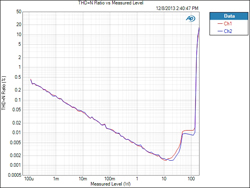
Conclusions about the Arcam AVR750 Receiver
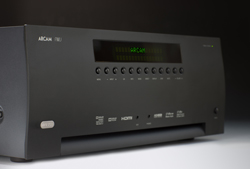
Many people will look at the price tag on the Arcam AVR750 and wonder why it costs so much. When you can go out and buy separates that offer better specs on paper, and more features, it is something one should ask.
To my ears the Arcam AVR750 always sounds wonderful. It does not impose its own character on recordings but instead remains neutral. It sounds great across the full audio spectrum while many receivers may have spectacular bass but ho-hum treble.
On the test bench the AVR750 looks good as well. There is a bit of an issue when using it to drive an external amp, but Arcam has a preamp version if that is what you want to do. It is also impossible to compare it to another product due to using 900mV with analog instead of the full 2V unity gain.
The Arcam AVR750 is a great receiver. It is one of the best sounding receivers I have used to date. Everything I listen to on the Arcam AVR750 sounds superb. The amplifier section performs admirably in my setup though my efficient speakers mean I rarely tap into the Class G section at all. As a single box solution for your home theater needs, the Arcam AVR750 is a wonderful choice that I find myself enjoying much more than I expected to. With a musical sound and a user-friendly design it is a component I can recommend for people to listen to.


